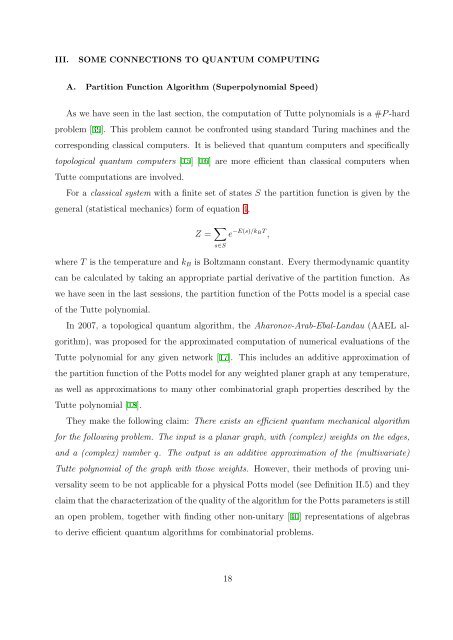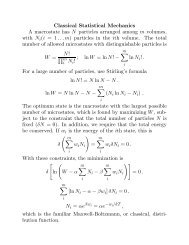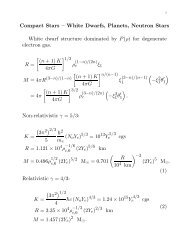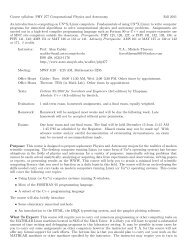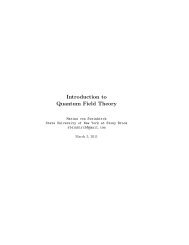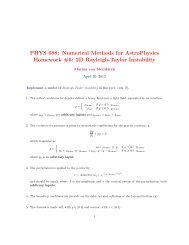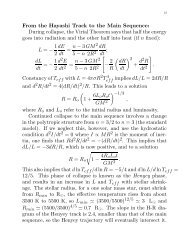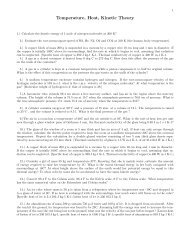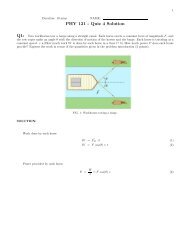On the study of the Potts model, Tutte and Chromatic Polynomials ...
On the study of the Potts model, Tutte and Chromatic Polynomials ...
On the study of the Potts model, Tutte and Chromatic Polynomials ...
You also want an ePaper? Increase the reach of your titles
YUMPU automatically turns print PDFs into web optimized ePapers that Google loves.
III.<br />
SOME CONNECTIONS TO QUANTUM COMPUTING<br />
A. Partition Function Algorithm (Superpolynomial Speed)<br />
As we have seen in <strong>the</strong> last section, <strong>the</strong> computation <strong>of</strong> <strong>Tutte</strong> polynomials is a #P -hard<br />
problem [39]. This problem cannot be confronted using st<strong>and</strong>ard Turing machines <strong>and</strong> <strong>the</strong><br />
corresponding classical computers. It is believed that quantum computers <strong>and</strong> specifically<br />
topological quantum computers [15] [16] are more efficient than classical computers when<br />
<strong>Tutte</strong> computations are involved.<br />
For a classical system with a finite set <strong>of</strong> states S <strong>the</strong> partition function is given by <strong>the</strong><br />
general (statistical mechanics) form <strong>of</strong> equation 4,<br />
Z = ∑ e −E(s)/kBT ,<br />
s∈S<br />
where T is <strong>the</strong> temperature <strong>and</strong> k B is Boltzmann constant. Every <strong>the</strong>rmodynamic quantity<br />
can be calculated by taking an appropriate partial derivative <strong>of</strong> <strong>the</strong> partition function. As<br />
we have seen in <strong>the</strong> last sessions, <strong>the</strong> partition function <strong>of</strong> <strong>the</strong> <strong>Potts</strong> <strong>model</strong> is a special case<br />
<strong>of</strong> <strong>the</strong> <strong>Tutte</strong> polynomial.<br />
In 2007, a topological quantum algorithm, <strong>the</strong> Aharonov-Arab-Ebal-L<strong>and</strong>au (AAEL algorithm),<br />
was proposed for <strong>the</strong> approximated computation <strong>of</strong> numerical evaluations <strong>of</strong> <strong>the</strong><br />
<strong>Tutte</strong> polynomial for any given network [17]. This includes an additive approximation <strong>of</strong><br />
<strong>the</strong> partition function <strong>of</strong> <strong>the</strong> <strong>Potts</strong> <strong>model</strong> for any weighted planer graph at any temperature,<br />
as well as approximations to many o<strong>the</strong>r combinatorial graph properties described by <strong>the</strong><br />
<strong>Tutte</strong> polynomial [18].<br />
They make <strong>the</strong> following claim: There exists an efficient quantum mechanical algorithm<br />
for <strong>the</strong> following problem. The input is a planar graph, with (complex) weights on <strong>the</strong> edges,<br />
<strong>and</strong> a (complex) number q. The output is an additive approximation <strong>of</strong> <strong>the</strong> (multivariate)<br />
<strong>Tutte</strong> polynomial <strong>of</strong> <strong>the</strong> graph with those weights. However, <strong>the</strong>ir methods <strong>of</strong> proving universality<br />
seem to be not applicable for a physical <strong>Potts</strong> <strong>model</strong> (see Definition II.5) <strong>and</strong> <strong>the</strong>y<br />
claim that <strong>the</strong> characterization <strong>of</strong> <strong>the</strong> quality <strong>of</strong> <strong>the</strong> algorithm for <strong>the</strong> <strong>Potts</strong> parameters is still<br />
an open problem, toge<strong>the</strong>r with finding o<strong>the</strong>r non-unitary [40] representations <strong>of</strong> algebras<br />
to derive efficient quantum algorithms for combinatorial problems.<br />
18


